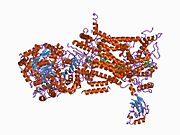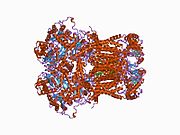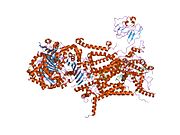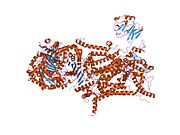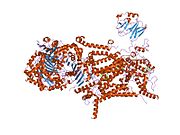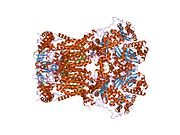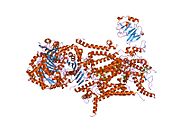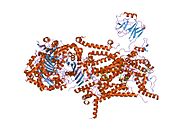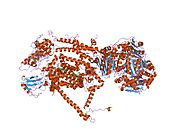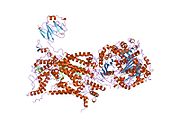Biology:CYC1
 Generic protein structure example |
Cytochrome c1, heme protein, mitochondrial (CYC1), also known as UQCR4, MC3DN6, Complex III subunit 4, Cytochrome b-c1 complex subunit 4, or Ubiquinol-cytochrome-c reductase complex cytochrome c1 subunit is a protein that in humans is encoded by the CYC1 gene. CYC1 is a respiratory subunit of Ubiquinol Cytochrome c Reductase (complex III), which is located in the inner mitochondrial membrane and is part of the electron transport chain. Mutations in this gene may cause mitochondrial complex III deficiency, nuclear, type 6.[1][2][3]
Structure
CYC1 is located on the q arm of chromosome 8 in position 24.3 and has 8 exons.[1] The CYC1 gene produces a 13.5 kDa protein composed of 130 amino acids.[4][5] CYC1 belongs to the cytochrome c family. CYC1 is a phosphoprotein and subunit of Ubiquinol Cytochrome c Reductase that binds heme groups. It has helix, transit peptide, and transmembrane domains and contains 9 alpha helixes, 5 beta strands, and 3 turns. The transmembrane protein passes through the inner mitochondrial membrane once and the majority of the protein is found on the intermembrane side. CYC1 contains covalent heme bindings sites at positions 121 and 124 and heme axial ligand iron-metal binding sites at positions 125 and 244.[2][3]
Function
CYC1 encodes a protein that is located in the inner mitochondrial membrane and is part of Ubiquinol Cytochrome c Reductase (complex III). The encoded protein, CYC1, is a respiratory subunit of the cytochrome bc1 complex, which plays an important role in the mitochondrial respiratory chain by transferring electrons from the Rieske iron-sulfur protein to cytochrome c.[1][2][3]
Species
CYC1 is a human gene that is conserved in chimpanzee, Rhesus monkey, dog, cow, mouse, rat, zebrafish, fruit fly, mosquito, C. elegans, S. cerevisiae, K. lactis, E. gossypii, S. pombe, N. crassa, A. thaliana, rice, and frog.[6] There are orthologs of CYC1 in 137 known organisms.[7]
Clinical Significance
Variants of CYC1 have been associated with mitochondrial complex III deficiency, nuclear, type 6. Mitochondrial complex III deficiency, nuclear, type 6 is an autosomal recessive disorder of the mitochondrial respiratory chain resulting from a defect in Ubiquinol Cytochrome c Reductase (complex III) that leads to reduced complex III activity. Clinical features tend to emerge in early childhood and include episodic acute lactic acidosis, ketoacidosis, insulin-responsive hyperglycemia, liver dysfunction, encephalopathy, and associated infection, although psychomotor development may remain normal. Pathogenic mutations have included c.288G>T, p.Trp96Cys and c.643C>T p. Leu215Phe.[2][3][8]
Interactions
CYC1 has 78 protein-protein interactions with 72 of them being co-complex interactions.[9] CYC1 is one of 11 subunits of Ubiquinol Cytochrome c Reductase (b1-c complex) that includes the respiratory subunits cytochrome b, cytochrome c1 (CYC1), UQCRFS1, the core proteins UQCRC1 and UQCRC2, and the low-molecular weight proteins UQCRH, UQCRB, UQCRQ, UQCR10, UQCR11, as well as an additional cleavage product of UQCRFS1.[2][3] Additionally, CCP1, CDKA-1, and CDKB1-1 have also been found to interact with CYC1.[9]
References
- ↑ 1.0 1.1 1.2 "Entrez Gene: CYC1 cytochrome c-1". https://www.ncbi.nlm.nih.gov/sites/entrez?Db=gene&Cmd=ShowDetailView&TermToSearch=1537.
- ↑ 2.0 2.1 2.2 2.3 2.4 "CYC1 - Cytochrome c1, heme protein, mitochondrial precursor - Homo sapiens (Human) - CYC1 gene & protein" (in en). https://www.uniprot.org/uniprot/P08574.
- ↑ 3.0 3.1 3.2 3.3 3.4 "UniProt: the universal protein knowledgebase". Nucleic Acids Research 45 (D1): D158–D169. January 2017. doi:10.1093/nar/gkw1099. PMID 27899622.
- ↑ Yao, Daniel. "Cardiac Organellar Protein Atlas Knowledgebase (COPaKB) —— Protein Information". https://amino.heartproteome.org/web/protein/E0CYC1.
- ↑ "Integration of cardiac proteome biology and medicine by a specialized knowledgebase". Circulation Research 113 (9): 1043–53. October 2013. doi:10.1161/CIRCRESAHA.113.301151. PMID 23965338.
- ↑ "CYC1 cytochrome c1 [Homo sapiens (human)"]. U.S. National Library of Medicine. https://www.ncbi.nlm.nih.gov/gene/1537.
- ↑ "ortholog_gene_1537[group"]. U.S. National Library of Medicine. https://www.ncbi.nlm.nih.gov/gene/?Term=ortholog_gene_1537%5Bgroup%5D.
- ↑ "Mutations in CYC1, encoding cytochrome c1 subunit of respiratory chain complex III, cause insulin-responsive hyperglycemia". American Journal of Human Genetics 93 (2): 384–9. August 2013. doi:10.1016/j.ajhg.2013.06.015. PMID 23910460.
- ↑ 9.0 9.1 "81 binary interactions found for search term CYC1". IntAct Molecular Interaction Database. EMBL-EBI. https://www.ebi.ac.uk/intact/interactions?conversationContext=3&query=CYC1.
External links
- Human CYC1 genome location and CYC1 gene details page in the UCSC Genome Browser.
Further reading
- "Role of HIV Vpr as a regulator of apoptosis and an effector on bystander cells". Molecules and Cells 21 (1): 7–20. February 2006. PMID 16511342.
- "Structural organization of the human mitochondrial cytochrome c1 gene". The Journal of Biological Chemistry 264 (3): 1368–74. January 1989. doi:10.1016/S0021-9258(18)94196-7. PMID 2536365.
- "Nucleotide sequence of a cDNA encoding the precursor to human cytochrome c1". Nucleic Acids Research 16 (8): 3577. April 1988. doi:10.1093/nar/16.8.3577. PMID 2836796.
- "Construction of a human cytochrome c gene and its functional expression in Saccharomyces cerevisiae". Journal of Biochemistry 103 (6): 954–61. June 1988. doi:10.1093/oxfordjournals.jbchem.a122393. PMID 2844747.
- "Novel purification of cytochrome c1 from mitochondrial Complex III. Reconstitution of antimycin-insensitive electron transfer with the iron-sulfur protein and cytochrome c1". The Journal of Biological Chemistry 260 (28): 15075–80. December 1985. doi:10.1016/S0021-9258(18)95704-2. PMID 2999105.
- "Isolation of a cDNA clone for human cytochrome c1 from a lambda gt11 expression library". Biochemical and Biophysical Research Communications 145 (1): 34–9. May 1987. doi:10.1016/0006-291X(87)91283-6. PMID 3036122.
- "Electrostatic interaction of cytochrome c with cytochrome c1 and cytochrome oxidase". The Journal of Biological Chemistry 256 (10): 4984–90. May 1981. doi:10.1016/S0021-9258(19)69355-5. PMID 6262312.
- "Oligo-capping: a simple method to replace the cap structure of eukaryotic mRNAs with oligoribonucleotides". Gene 138 (1–2): 171–4. January 1994. doi:10.1016/0378-1119(94)90802-8. PMID 8125298.
- "Assignment of the gene for the cytochrome c1 subunit of the mitochondrial cytochrome bc1 complex (CYC1) to human chromosome 8q24.3". Genomics 19 (2): 400–1. January 1994. doi:10.1006/geno.1994.1084. PMID 8188279.
- "Construction and characterization of a full length-enriched and a 5'-end-enriched cDNA library". Gene 200 (1–2): 149–56. October 1997. doi:10.1016/S0378-1119(97)00411-3. PMID 9373149.
- "A mitochondrial cytochrome b mutation but no mutations of nuclearly encoded subunits in ubiquinol cytochrome c reductase (complex III) deficiency". Human Genetics 104 (6): 460–6. June 1999. doi:10.1007/s004390050988. PMID 10453733.
- "Control of mitochondrial membrane permeabilization by adenine nucleotide translocator interacting with HIV-1 viral protein rR and Bcl-2". The Journal of Experimental Medicine 193 (4): 509–19. February 2001. doi:10.1084/jem.193.4.509. PMID 11181702.
- "Cytochrome c release upon Fas receptor activation depends on translocation of full-length bid and the induction of the mitochondrial permeability transition". The Journal of Biological Chemistry 277 (12): 10073–82. March 2002. doi:10.1074/jbc.M111350200. PMID 11790791.
- "HIV-1 Vpr induces apoptosis through caspase 9 in T cells and peripheral blood mononuclear cells". The Journal of Biological Chemistry 277 (40): 37820–31. October 2002. doi:10.1074/jbc.M205313200. PMID 12095993.
- "Adenovirus encoding HIV-1 Vpr activates caspase 9 and induces apoptotic cell death in both p53 positive and negative human tumor cell lines". Oncogene 21 (30): 4613–25. July 2002. doi:10.1038/sj.onc.1205549. PMID 12096338.
- "The mitochondriotoxic domain of Vpr determines HIV-1 virulence". The Journal of Clinical Investigation 111 (10): 1455–7. May 2003. doi:10.1172/JCI18609. PMID 12750393.
- "Vpr R77Q is associated with long-term nonprogressive HIV infection and impaired induction of apoptosis". The Journal of Clinical Investigation 111 (10): 1547–54. May 2003. doi:10.1172/JCI16233. PMID 12750404.
- "Involvement of cytochrome c release and caspase-3 activation in the oxidative stress-induced apoptosis in human tendon fibroblasts". Biochimica et Biophysica Acta (BBA) - Molecular Cell Research 1641 (1): 35–41. June 2003. doi:10.1016/S0167-4889(03)00047-8. PMID 12788227.
- "Critical upstream signals of cytochrome C release induced by a novel Bcl-2 inhibitor". The Journal of Biological Chemistry 279 (18): 19133–40. April 2004. doi:10.1074/jbc.M400295200. PMID 14966123.
This article incorporates text from the United States National Library of Medicine, which is in the public domain.
 |

